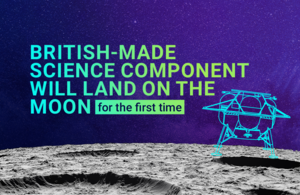British-made science component on way to land on the moon for the first time as historic Peregrine Mission One launches
A major global space mission has launched today that will see a British-built science component land on the moon for the first time.

British-made science component will land on the moon for the first time.
- Astrobotic’s Peregrine Mission One will see an uncrewed spacecraft orbit the moon before landing on its surface, with science aiming to advance our understanding of the availability of resources such as water, which could be used for more sustained human exploration
- the Lunar Lander features a NASA science instrument called the ‘Peregrine Ion Trap Mass Spectrometer’ (PITMS), with an integral component, the Exospheric Mass Spectrometer (EMS), developed in the UK
- the use of PITMS achieves historic milestone for UK space, as it will be the first UK and European science component to touch down on the surface of the Moon
A major global space mission that will see a British-built science instrument land on the moon for the first time is underway as Astrobotic’s Peregrine Mission One launched today (Monday 8 January).
The Mission will see the Peregrine Lunar Lander spend time orbiting Earth, and then the Moon before beginning its dramatic descent and historic landing, expected to be around mid-February.
Launched from Cape Canaveral in Florida, it includes a scientific instrument, known as the Peregrine Ion Trap Mass Spectrometer. A key component of PITMS has been developed in the UK through £14 million of Government funding through the UK’s membership of the European Space Agency.
The PITMS instrument will explore the Moon’s atmosphere, by measuring water and other molecules, and unlock the mysteries of its ‘water cycle,’ as can be observed on Earth. This study of volatile substances - materials that can turn into gas – will provide valuable insights into lunar composition and conditions. The data collected will contribute to our understanding of the Moon’s potential to provide resources like water, opening new possibilities for future human presence on the lunar surface.
The UK-built component – called the Exospheric Mass Spectrometer – was developed under a European Space Agency contract by scientists at The Open University and RAL Space, UK’s national space lab. It represents the first instrument on the Moon that has been built in the UK and in Europe and embodies the UK’s commitment to economic growth, showcasing the nation’s prowess in cutting-edge space technology.
As part of the PITMS, the Exospheric Mass Spectrometer allows researchers to study atoms and molecules in a gas. Lunar molecules in the Moon’s exosphere will enter the PITMS, be turned into ions, and then stored in an electric field – known as the ‘ion trap’. The ions are released from the trap into the detector, unveiling their chemical makeup and helping scientists to decipher the Moon’s composition.
The Peregrine Lunar Lander carries a suite of diverse NASA and commercial ‘payloads’– often scientific or technological instruments, carried on board a spacecraft for a specific purpose.
Notably, among these commercial payloads are items which add a touch of human creativity to space exploration, including a time capsule, a bitcoin, and even a music album.
Science and Technology Secretary, Michelle Donelan said:
The Exospheric Mass Spectrometer will be the first science component developed in the UK destined for the lunar surface, marking a historic moment for the UK space industry.
This significant achievement also lays the groundwork for understanding how to sustain extended human presence on the Moon in the future – changing the way humankind interacts with the solar system around us forever.
It is also a further sign of our close collaboration with international partners like NASA who I recently visited at the Johnson Centre, where we even discussed the potential for British astronauts to reach the moon in the future.
Understanding water on the Moon is an important part of the Artemis programme, to explore more of the lunar surface than ever before.
NASA contracted Astrobotic as its commercial partner and Peregrine Mission One to provide payload services via the Commercial Lunar Payload Services Initiative for five NASA-provided payloads, of which the PITMS is one.
Libby Jackson, Head of Space Exploration at the UK Space Agency, said:
The Peregrine Lunar Lander will help pave the way for further exploration of our Solar System. Witnessing the first instrument from the UK, and indeed Europe, launch to the Moon is a hugely exciting moment. We are looking forward to seeing Peregrine safely on the surface and the return of important data from PITMS to help unlock the secrets of water on the moon.
It’s fantastic to see our skilled UK experts at the heart of an international mission that will support future long-term presence in space.
Commenting on RAL Space’s contribution, Prof. Mark Thomson, Executive Chair of STFC, said:
Ambitious plans for future space exploration, including crewed missions to the Moon and Mars, will need to be informed by new scientific data. The cutting-edge instrumentation on the Peregrine Lunar Lander will gather essential data from the surface of the moon, paving the way for future missions that will inspire the next generations. STFC and RAL Space are proud to have been able to provide our world-leading expertise in space technology to contribute to the success of this mission.
Roland Trautner, ESA EMS Project Manager said:
As the first ESA payload destined to land on the lunar surface, the Exospheric Mass Spectrometer (EMS) - which forms the heart of the ESA-NASA PITMS instrument - is a groundbreaking instrument for ESA, both as a technology demonstrator and for lunar science. PITMS will answer key questions on the Moon’s exosphere and its evolution, providing invaluable insights into availability and possible utilisation of potential resources for future space exploration, including production of fuel, food and energy. The EMS technology is also a key building block for future instruments for lunar exploration, and new flight opportunities have been identified already.